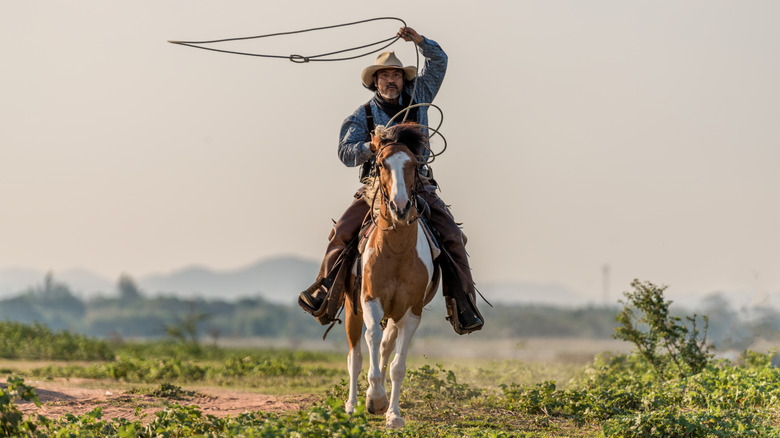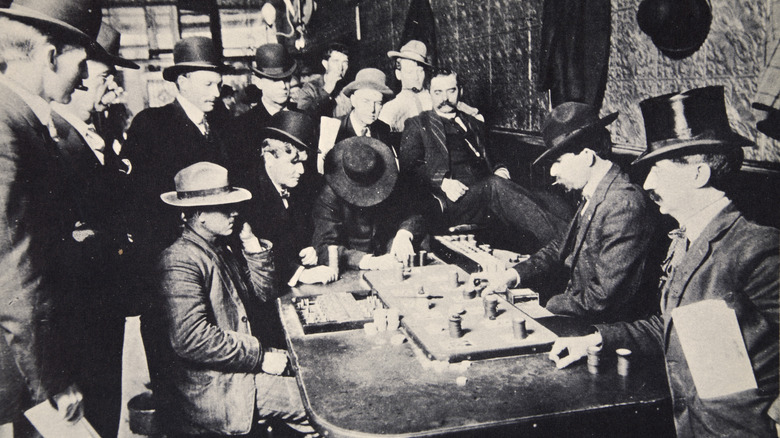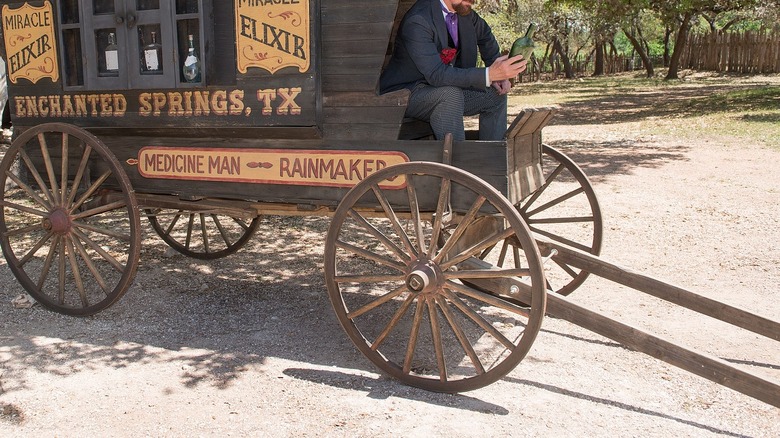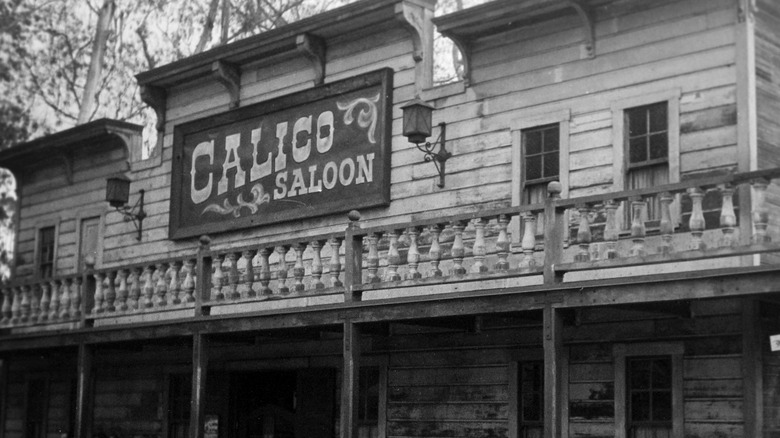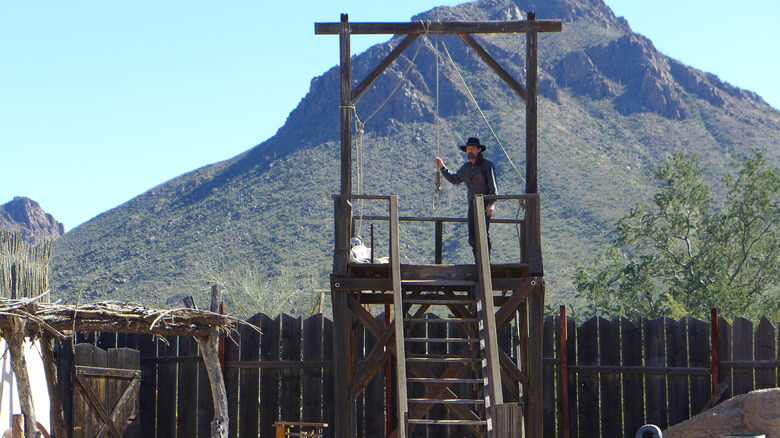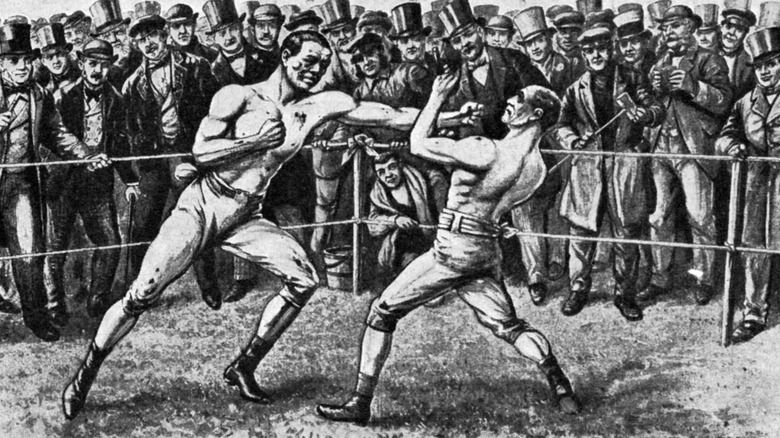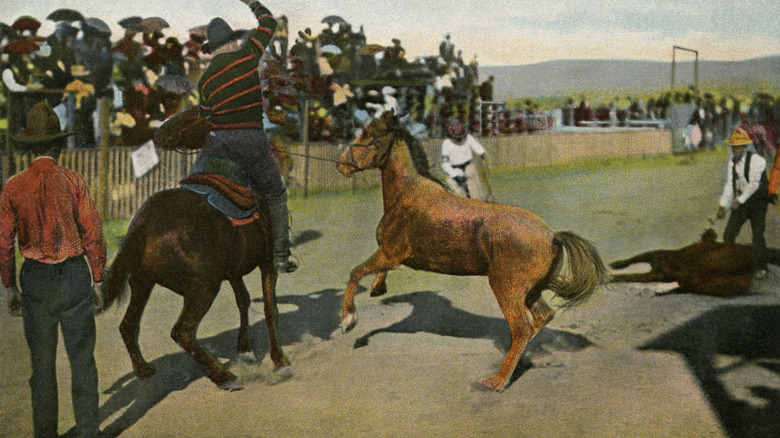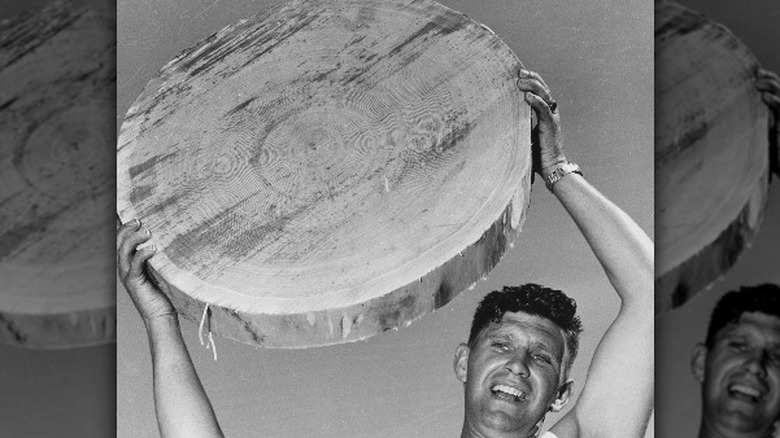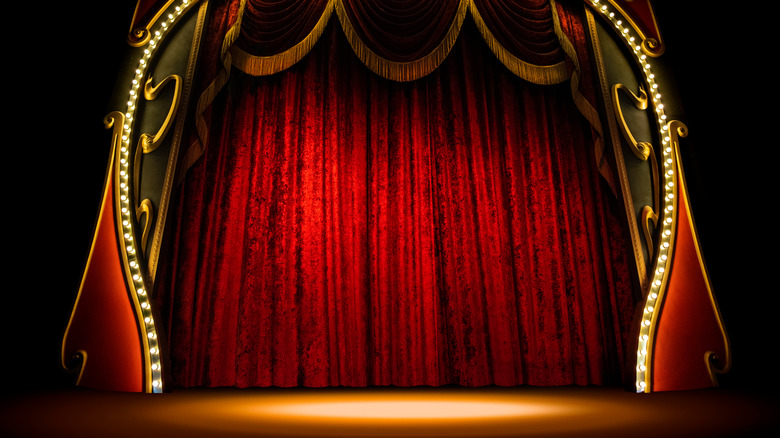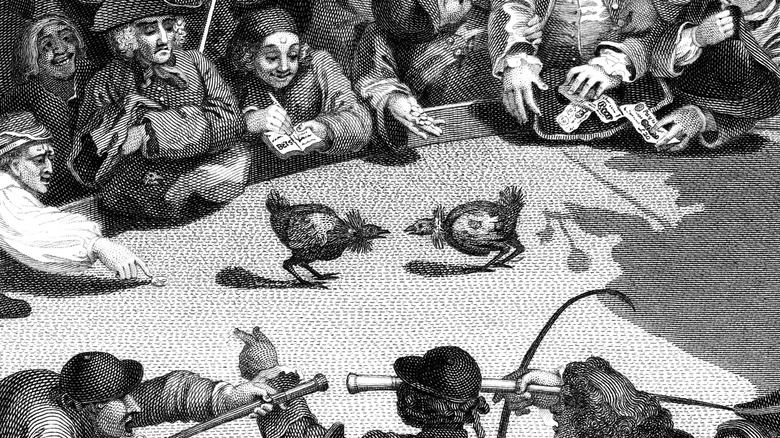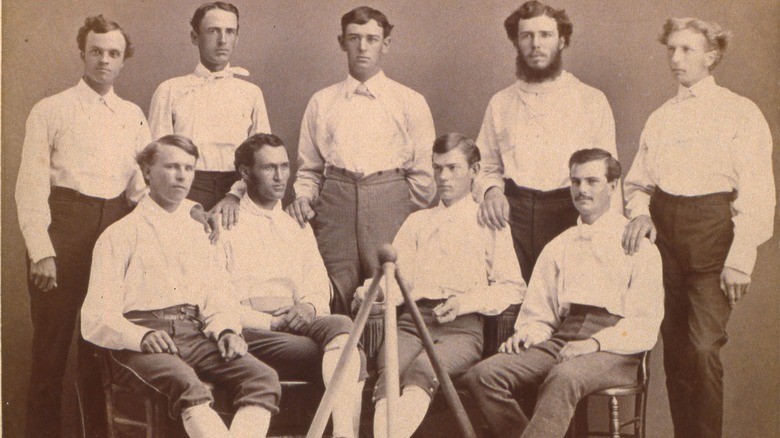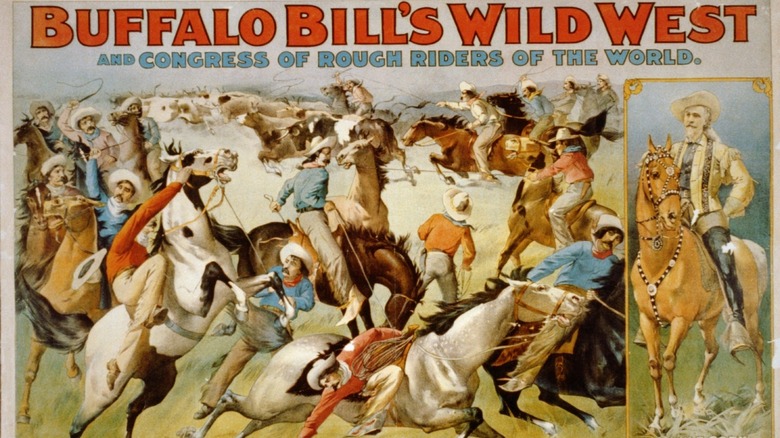What Entertainment In The Wild West Was Really Like
The Wild West is full of lore, both steeped in fact and outlandishly overblown, but it has led to a pretty consistent image of what life was like there. Raging outlaws ran rampant, collecting all the hard-earned money from business people eager to make a living, while sheriffs tried to protect the cash flow, but it was never enough. All these were built into the Old West aura by building up the outlaw aspect — that wasn't nearly as prominent as it's portrayed.
Underneath all this was a steady way of life for the everyday workers and commoners, who were just trying to make a living in a frontier town. And sure, sometimes bandits got in the way, but these barkeeps, hotel workers, cowboys, and laborers still needed a way to enjoy life outside of work. Perhaps unsurprisingly, entertainment in the Old West was just as wild as the general portrayal of the era as a whole. This was a land of freedom and relatively tame laws, which allowed for some pretty liberal explorations of fun and excitement, many of which simply involved showmanship and the power of the creative mind to get money out of a viewing audience.
Let's look at how folks in the Wild West cut loose and enjoyed their time.
Gambling
There are several aspects of the Wild West that have been glamorized beyond their actual historical authenticity — the sheer wildness of it, for instance. But one thing that is just as big as we're led to believe is the presence of gambling. Gambling was so widespread in the American West that saloons had to hire employees whose specific job was to keep the gambling tables in order — which proved quite difficult sometimes since gambling wasn't always fun and games.
While HistoryNet notes that the early iterations of western gambling were solely recreational and meant to provide a little entertainment to the hard-working frontier laborers, what it manifested into, in the saloons of the Wild West, was more serious and often even deadly. However, it was still one of the most widespread activities of the time, and the games were numerous, too. This wasn't just poker or craps. Legends of America names a few of the most popular games as "Chuck-A-Luck, Three Card Monte, High Dice, and Faro."
HistoryNet credits the boom of gambling in the West to the temperament of the people doing the gambling. Seeing how they left the comfortable life out east behind to pursue riches in the West, they were inherently risk-taking gamblers. This also led to a raucous time around the gambling tables, with the games often leading to guns drawn amid accusing cries of cheating. Gamblers were in for a fraught atmosphere, with guns strapped to their sides, knowing everyone at the table was doing the same. And when tensions erupted, things rarely went well.
Medicine Shows
While forms of entertainment like gambling and rodeos have carried on into the modern day, it's hard to find an equivalent for the Old West medicine show, which was a staple on the entertainment landscape of the Wild West. According to Jeremy Agnew's book, "Entertainment in the Old West," people flocked en masse to medicine shows, which were exactly as they sound — someone got up and pitched a brand new medicine that's meant to heal all ailments. The salespeople were such showmen that the sales pitch itself became a reliable form of entertainment, hence the large crowds.
The medicine show also borrowed elements from other forms of Wild West entertainment, such as circuses, side shows, and more, but the end goal was to make a sale. For the audience, they either wanted to find medicine to help them, or they wanted to gawk at the showmanship on display. Agnew points out that the business of selling medicine via said medicine shows earned about 80 million dollars annually, which should go to show just how popular they were.
And while a sale of medicine may sound drab, Brooks McNamara's article "The Indian Medicine Show" (via the Educational Theatre Journal) highlights just how dazzling these shows were. They included everything from burlesque shows to pie-eating contests, and even dog and pony shows. In addition, the salespeople dressed up to impersonate Quakers, Native Americans, and more, all in hopes of padding the bulging pocket of exploitation.
Saloons
What is more Wild West than the saloon? As far as entertainment goes, much of it took place in saloons, but they were, in and of themselves, massive hubs of entertainment. Sure, you could gamble at a saloon, but you could also drink, listen to music, fraternize, and otherwise make merry. And, of course, saloons often doubled as brothels. In fact, according to Catherine Holder Spude's article "Brothels and Saloons: An Archaeology of Gender in the American West" (via Historical Archaeology), women weren't even allowed in saloons. Those that worked there were there for one thing — sex work.
As Spude points out, saloons were the center of any given camp or town: It's where everyone went. And the forms of entertainment found within their walls were just as diverse as the population it attracted. Soldiers, miners, and laborers of all sorts gathered in the town saloon. Or saloons, rather, since Legends of America mentions that in Livingston, Montana, a town of 3,000, there were 33 saloons. That's one saloon for every 100 people.
Whiskey was the main beverage served, but it wasn't whiskey by today's standards. According to Legends of America, it was raw alcohol, burnt sugar, and chewing tobacco. They also served cactus wine, which brought together tequila and peyote tea, as well as room temperature beer, straight rye liquor, and the aptly-named rotgut, which was a terrifying 100-proof liquor mixed with turpentine, ammonia, gunpowder, or cayenne.
Public Hangings
Many cultures throughout history thought nothing drew a crowd like seeing someone else hang from the gallows, with public, often ritualistic ceremonies to showcase the power of the law to the public. And that's what it primarily stemmed from, according to The Baltimore Sun — the rulers wanted to show the ruled what happened when you broke those rules. And while that lesson was certainly imparted on the pubic, they also found a certain joy in delighting in the death of others.
The entire ordeal in the Wild West would have been quite elaborate. A procession from the jailhouse with the condemned bound and surrounded by law officers. Citizens could follow the procession from the start, hurling insults (or cabbages), or barking for their release, perhaps mourning if family and friends came out. Once the condemned reached the gallows, they were given their last rites and hung by their neck to the cheers and jeers of the crowd.
While public hangings weren't an everyday affair, they weren't exactly uncommon. The Los Angeles Sheriff's Department describes 40 legal hangings and 32 vigilante executions taking place between 1851 and 1874. And that's just in Los Angeles. According to "Entertainment in the Old West," another town in California, formerly known as Old Dry Diggings, was renamed Hangtown in 1850 to celebrate how many people were hanged there. It only took four years to change the name again, but regardless — a lot of hangings dangled around in the Old West.
Boxing
Believe it or not, in the wildness of the Wild West, organized sports did, in fact, exist, and one of the most popular sports for participants and audiences alike was boxing. They had titles and all, fought for prizes including money and trophies, and while local governments flitted back and forth between letting boxing stay legal or not, according to Jeremy Agnew's book "Entertainment in the Old West," the public outcry was loud and clear — they really wanted to see two men beat the snot out of each other. In fact, where it was illegal, certain loopholes were found, such as staging a play in a theater where one of the acts happened to include a boxing match — which was the reason why everyone was really there.
The excitement surrounding a match was much like today. Before the match itself, people would speculate and discuss, argue and fight over who would win. They'd place bets, they'd rally among like-minded fans, and after the match, the same discussions ensued: Who deserved the win, who fought dirty, and was the referee biased?
In a specific instance of boxing celebrity, OK Corral participant Wyatt Earp found his way into refereeing boxing matches and became a well-known face on the West Coast boxing circuit, according to The Guardian. And while boxing was technically illegal in 1891 in the city of San Francisco, that didn't stop the Mechanics Pavilion from selling 10,000 tickets.
Rodeos
Few things are more American than a good, old-fashioned rodeo, despite originating in Mexico and dating back to the conquistadors. Still, once rodeos touched down in the American West, there was no stopping how popular they'd become. The first organized rodeo to pop up in the American territories came in 1852, where else but Texas, according to American Cowboy. Of course, this event was headlined as bullfighting, while the rodeo was nothing more than a secondary venue. However, the rodeo garnered so much attention that news spread all over the United States.
Any given "rodeo" event would have encompassed a good deal of side attractions, not just the bucking bulls that are still popular today. There also would have been lassoing, racing, steer-wrestling, and practically anything else you can conceive of doing with irritated cattle desperate to shake off any annoying human.
Thanks to the likes of Bill Pickett and Buffalo Bill, the rodeo became ingrained in the Wild West, with massive, sprawling events boasting all kinds of amenities and attractions, according to Mountain Top Rodeo. They traveled the Wild West, making a fortune off their talents.
Competitions
Ever since time began, people have been competing against one another, certainly for survival at least. This developed into less lethal activities such as tests of strength and endurance, the Olympics, and literally every other sporting event ever. The culture of the Wild West was fertile soil for this ongoing trend of seeing two or more people pitted against each other in the name of sport.
Most of these competitions evolved out of the industries prevalent in the American West, such as logging and mining. According to True West Magazine, out of those industries and more came the likes of rock drilling, steamboat racing, log rolling, and ax throwing. And no competition was complete without a cheering crowd. But not all competitions sprang out of industry. Skating competitions, both on ice and on wheels, also drew crowds, as well as gymnastics and races of all sorts — foot, horse, and even sleigh. Many competitors became hometown heroes, communities rallied around them, and they became like the icons that populate the various sporting stages today.
Some competitions have survived into the modern day: In February of 2022, 12News reported on a cowboy shooting competition that brought together 700 modern cowboys in Phoenix, Arizona, an event that has its roots in the 1800s.
Minstrel Shows
By far the least flattering form of entertainment to come out of the Old West, minstrel shows did not age well. Britannica defines minstrel shows as "the comic enactment of racial stereotypes," and it's hard to think of a more succinct way to describe it. Yet, in the Old West, minstrel shows were all the rage. They began by creating one of the most notorious performance styles in modern history: Blackface. And while that origin began in 1830s New York, it grew far more popular in the West through shows that evolved into its very own industry, with unique styles, costumes, and makeup, according to the National Museum of African American History and Culture.
But these shows brought more than just harmful stereotyping, according to Britannica, although this distortion was always its foundation. The performances included music, dance, and sometimes even burlesque and opera, though always through a mocking, comedic lens.
While minstrel shows evolved to include white and Black performers, as well as adding women, growing inclusiveness and tolerance in society meant they had an expiration date, and so disappeared around the 1950s, per Britannica. Nonetheless, their artistic legacy — if you can call it that — persisted in music and television shows of later decades.
Animal Fights
Emblematic of the American West's cruelty, animal fights were a huge source of entertainment, and there was a whole mess of variety for any fans of watching this cruel blood sport. Animal fights could include any manner of combatants, but the most popular were dog fights, cock fights, and the bizarre and brutal bear and bull fights. Cock fighting and dog fighting involved trainers pitting their champion animals against another trainer's. According to the Oklahoma Historical Society, cock fights in particular had very specific aesthetics: A fighting arena lined with wood or chicken wire, with benches or stadium seating to allow for public viewing — all for a price, of course. And the noise level would have been raucous, with the two chickens fighting to the death in front of a crowd shouting over the din of chatter, almost always emboldened by betting and booze.
Bull and bear fighting, meanwhile, was another staple out west, particularly in California. Tracing its origins back to Ancient Rome, these events were standard Sunday afternoon entertainment for most. Right after church, they would flock to the bear pit to watch two animals battle to death — the bear collared to a pole, defending itself from a raging bull, according to Atlas Obscura. It was always the main event in an afternoon full of festivities.
This sport was so widespread that the California grizzly bear, which was estimated at 10,000 strong at one point, went extinct from the sport that goaded them into forced combat.
Baseball
The untamed Wild West may not be commonly associated with the great American pastime of baseball, but believe it or not, there was a crossing of the two — and it was a successful crossing. According to HistoryNet, when the creator of baseball, Alexander Joy Cartwright Jr., decided to join the California gold rush, he brought his game with him, complete with bats, balls, and the enthusiasm of a burgeoning sport that had already caught on in New York and New Jersey.
From that moment, the sport caught on in the West, and while no professional leagues were formed, the organized sport was played throughout western towns and settlements. Teams popped up everywhere, with San Francisco boasting two teams — the Eagles and the Red Rovers. Oakland founded the Live Oaks, and Kansas City formed the Antelopes, who even Wild Bill Hickock was reportedly a fan of. But it wasn't just bigger settlements that formed teams. Small towns like Nininger City, Minnesota, now a ghost town, had their own baseball team before they faded away.
It was in 1869, though, that baseball really ignited out west: According to True West Magazine, the Cincinnati Red Stockings went on a tour out west from St. Louis and played against numerous amateur teams scattered across the frontier, culminating in an exhibition against the San Francisco Eagles. In front of a sellout crowd, the Eagles were defeated, but the West's fervor for the sport only grew more.
Circuses
Circuses took on many forms in the American west, but whatever form they took, the general line of entertainment was the same. All manner of performances took place, from Russian Cossack riders to trapeze artists, animal acts that would nowadays be classed as animal cruelty, and main events that brought the scattered crowd altogether in one final, grand crescendo.
Perhaps the best-known show of the west was Buffalo Bill's Wild West, which he showcased around America, according to the University of Sheffield. He included somewhat inaccurate historical reenactments, as well as Native Americans, exotic animals, rodeos, various other sports, and essentially a one-stop showing of all things that are now associated with the Wild West.
These types of shows coincided with the growth of more traditional circuses such as Barnum & Bailey and the Ringling Brothers, both of which included similar elements such as fairgrounds and exotic animals, per Britannica.
